The Jeep as a Machine Gun Carrier and Weapons Mount
From the start, the Jeep was being envisioned as a carrier of machine guns and other weapons, such as mortars and even 37 mm. cannon. The BRC, MA, and GP all went through this development phase, there are even pictures showing provisions for tripod mounted machine guns: each of them had tie-down brackets on the body upper right hand corners specifically for this purpose. Each prototype of course had some version of the machine gun pedestal mount, but this was only standardized in the MB/GPW.
The M31 pedestal mount with twin bracing was successful, but the problem was that the standing position of the machine gunner offered a tempting target to enemy snipers. This concern led to a subsequent development, the M48 which was mounted on the right dash of the vehicle, the gunner now being comfortably seated on the right front seat. The problem with the M48 was that no amount of bracing on the thin metal gauge cowl, sides and firewall could take the massive recoil of automatic fire. Thus the M48 was not quite so popular, not being as sturdy as the M31. Further, pictures show a rather limited amount of space for the gunner to manipulate his weapon.
On the MB/GPW, the more commonly used US machine guns were the air cooled .30 cal. M1919s which was lighter and simpler than the water-cooled .30 cal. M1917s, and very infrequently due to its weight and recoil the .50 cal M2 HB (Heavy Barrel). The British used Bren guns and sometimes the earlier Vickers K's and the WWI Lewis guns common with the SAS, and the Russians favoured their extremely heavy Maxim and Goryunov Machine guns. While many photos show the .50 cal. M2HB mounted on the Jeep, practically only the .30 and .303 cal. machine guns could function on the Jeep without straining its body and frame. For the same reason, trials using the 37 mm cannon fared poorly, and it was instead mounted on the Dodge 3/4 Ton 4 x 4, where it became the M6 Gun Motor Carriage, a totally undistinguished piece of equipment due to the gun's limitations.
Until the 75 mm, 105 mm and 106 mm recoilless rifles came along, there was really no heavier calibre weapons used, except crew carried "Bazookas"; the recoilless rifles mentioned above came too late for WWII operations. The secret in mounting weapons on vehicles will always be how to handle the recoil.
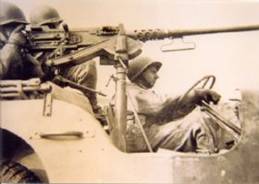
A GPW fitted with a Cal.50 HB M2 machine gun on a non standard pedestal mount. Note mount is shorter than the standard M31s and is mounted too far forward.
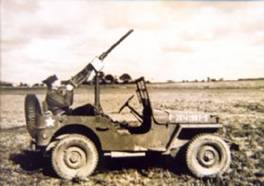
On early tests in 1942, this MB was tested with a new type machine gun mount by the USMC in San Diego.
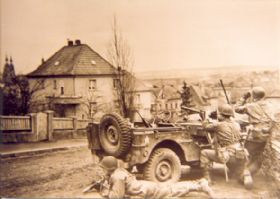
An early MB fitted with a water cooled 30 Cal Browning and mount. Note no glove box and Jerry can mount = early ‘slat grill MB’. New Caledonia, Oct `42.
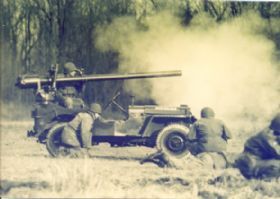
Soldiers of the 28th CB Sq Mech VII Corps lay mortar fire on enemy machine gun nest in the woods. Note variety of weapons mounted on the Jeeps. Germany 30 Sept. `44.
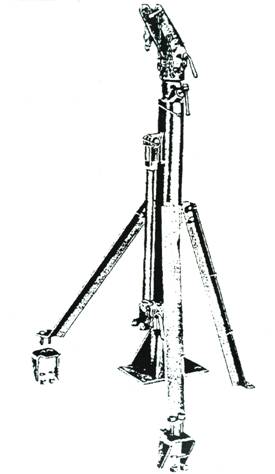
Jeeps of the 3rd Armoured Div, in training at Iron Mountain, California, carrying a variety of ordnance: Cal 30 and Cal 50 MG’s. Note low mounting of the Cal 30 MG on the left Jeep. `42.
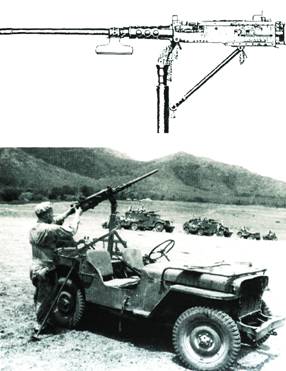
One of the most common mounts was the M31 Pedestal mount on this GPW. Here shown carrying a Cal 30 M1919A4 MG on a D7431 cradle. Italy. 27 Sept. `43.
An MB-mounted 105 Recoilless Rifle being tested at Aberdeen Proving Grounds. This was probably the prototype of the 105mm RR M27, which in turn was the forerunner of the present 106mm RR M40A1, which is the standard Jeep-mounted antitank weapon of the U.S. Army. Note the semi-floating rear axle on this late MB, the glossy OD paint, the lack of a front seat back cushions which probably gave more legroom, the muzzle cover on the grill, and the gun travelling lock on the cowl. 14 Dec. `50.